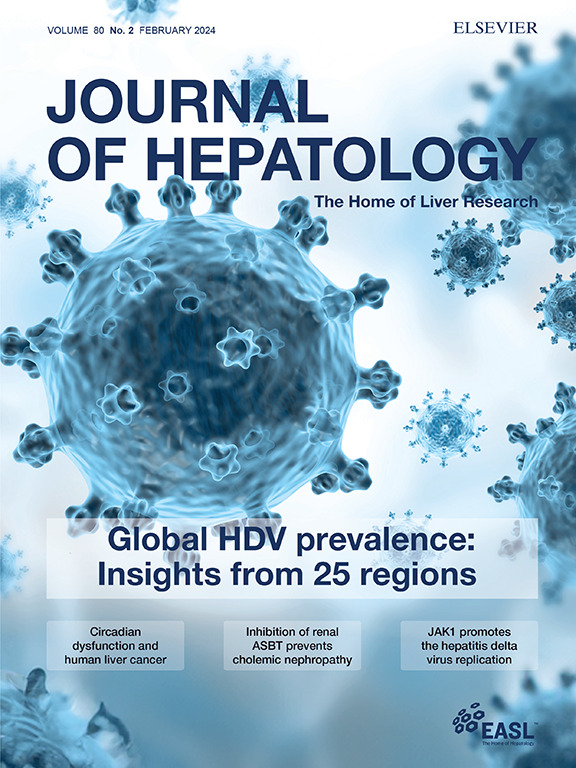Decoding the Resistin-CAP1 Pathway in Intermediate Monocytes Mediating Liver Allograft Rejection
IF 26.8
1区 医学
Q1 GASTROENTEROLOGY & HEPATOLOGY
引用次数: 0
Abstract
Background & Aims
Lymphocytes are widely recognized as the primary mediators of cellular rejection post-liver transplantation. However, conventional immunosuppressive regimens that target lymphocytes, such as calcineurin phosphatase inhibitors, corticosteroids, or lymphocyte-depleting antibodies, can only partially mitigate rejection while inducing severe adverse effects. This necessitates the search for novel immunotherapeutic targets.Methods
We harnessed the power of single-cell RNA sequencing and spatial transcriptome in 24 rat transplanted liver and peripheral blood single nucleated cells (PBMCs) samples to derive gene expression signatures recapitulating 13 cell phenotypes. We used flow cytometry, multifactor assays and multiple recombinant assays to validate in vitro and in vivo the role of the target protein Resistin on human T-cell function, as well as the Resistin-CAP1 interaction. Gold nanoparticles were used to package Retn siRNA sequences to validate the role of Retn knockdown on acute rejection after liver transplantation.Results
By distinguishing between donor and recipient cells, we delineate the dynamic landscape of immune cells during allograft rejection and their spatial distributions across donors and recipients. Our findings underscore the pivotal role of recipient derived intermediate monocytes in cellular rejection. Using CellChat ligand-receptor analysis, we identify the Resistin-CAP1 pathway as a key mechanism by which intermediate monocytes participate in T cell-mediated rejection reactions. We confirm that Resistin knockdown significantly alleviates acute rejection after rat liver transplantation, markedly extending the survival of recipients using innovative nanogold technology.Conclusion
These findings offer insights into the dynamic changes in the alloimmune microenvironment, pinpointing intermediate monocytes as potential diagnostic and immunotherapeutic targets during allograft rejection. This study holds significant importance in advancing non-invasive diagnostic technologies and immunotherapeutic strategies for allogeneic rejection.Impact and implications
This study pioneers the application of spatial transcriptomics in liver transplantation, providing a comprehensive analysis of immune cell spatial distribution, complemented by Souporcell-based chimerism assessment. We demonstrate that intermediate monocytes play a pivotal role in T cell-mediated acute rejection via the Resistin-CAP1 signaling axis. Targeting this pathway using nanogold-siRNA technology effectively mitigates rejection and enhances graft survival. These findings contribute novel insights into the mechanisms of transplant rejection and present promising avenues for the development of targeted therapeutic and diagnostic strategies in liver transplantation.

解码中间单核细胞介导肝移植排斥反应的抵抗素- cap1通路
背景,目的淋巴细胞被广泛认为是肝移植后细胞排斥反应的主要介质。然而,传统的针对淋巴细胞的免疫抑制方案,如钙调磷酸酶抑制剂、皮质类固醇或淋巴细胞消耗抗体,只能部分减轻排斥反应,同时会引起严重的不良反应。这就需要寻找新的免疫治疗靶点。方法利用单细胞RNA测序和空间转录组技术对24例大鼠移植肝和外周血单核细胞(PBMCs)样本进行分析,获得13种细胞表型的基因表达特征。我们利用流式细胞术、多因素实验和多重重组实验验证了靶蛋白抵抗素对人t细胞功能的作用,以及抵抗素- cap1的相互作用。我们使用金纳米颗粒包装Retn siRNA序列,以验证Retn敲除在肝移植后急性排斥反应中的作用。结果通过对供体和受体细胞的区分,我们描绘了同种异体移植排斥反应中免疫细胞的动态景观及其在供体和受体之间的空间分布。我们的发现强调了受体衍生的中间单核细胞在细胞排斥中的关键作用。使用CellChat配体受体分析,我们确定了抵抗素- cap1途径是中间单核细胞参与T细胞介导的排斥反应的关键机制。我们证实,利用创新的纳米金技术,抵抗素敲低可显著减轻大鼠肝移植后的急性排斥反应,显著延长受体的生存期。结论这些发现为了解同种异体免疫微环境的动态变化提供了新的思路,指出中间单核细胞是同种异体移植排斥反应的潜在诊断和免疫治疗靶点。本研究对推进同种异体排斥反应的无创诊断技术和免疫治疗策略具有重要意义。影响和意义本研究开创了空间转录组学在肝移植中的应用,提供了免疫细胞空间分布的综合分析,并辅以基于小细胞的嵌合评估。我们证明中间单核细胞通过抵抗素- cap1信号轴在T细胞介导的急性排斥反应中起关键作用。利用纳米金- sirna技术靶向这一途径,可有效减轻排斥反应,提高移植物存活率。这些发现为移植排斥反应的机制提供了新的见解,并为肝移植靶向治疗和诊断策略的发展提供了有希望的途径。
本文章由计算机程序翻译,如有差异,请以英文原文为准。
求助全文
约1分钟内获得全文
求助全文
来源期刊

Journal of Hepatology
医学-胃肠肝病学
CiteScore
46.10
自引率
4.30%
发文量
2325
审稿时长
30 days
期刊介绍:
The Journal of Hepatology is the official publication of the European Association for the Study of the Liver (EASL). It is dedicated to presenting clinical and basic research in the field of hepatology through original papers, reviews, case reports, and letters to the Editor. The Journal is published in English and may consider supplements that pass an editorial review.
 求助内容:
求助内容: 应助结果提醒方式:
应助结果提醒方式:


